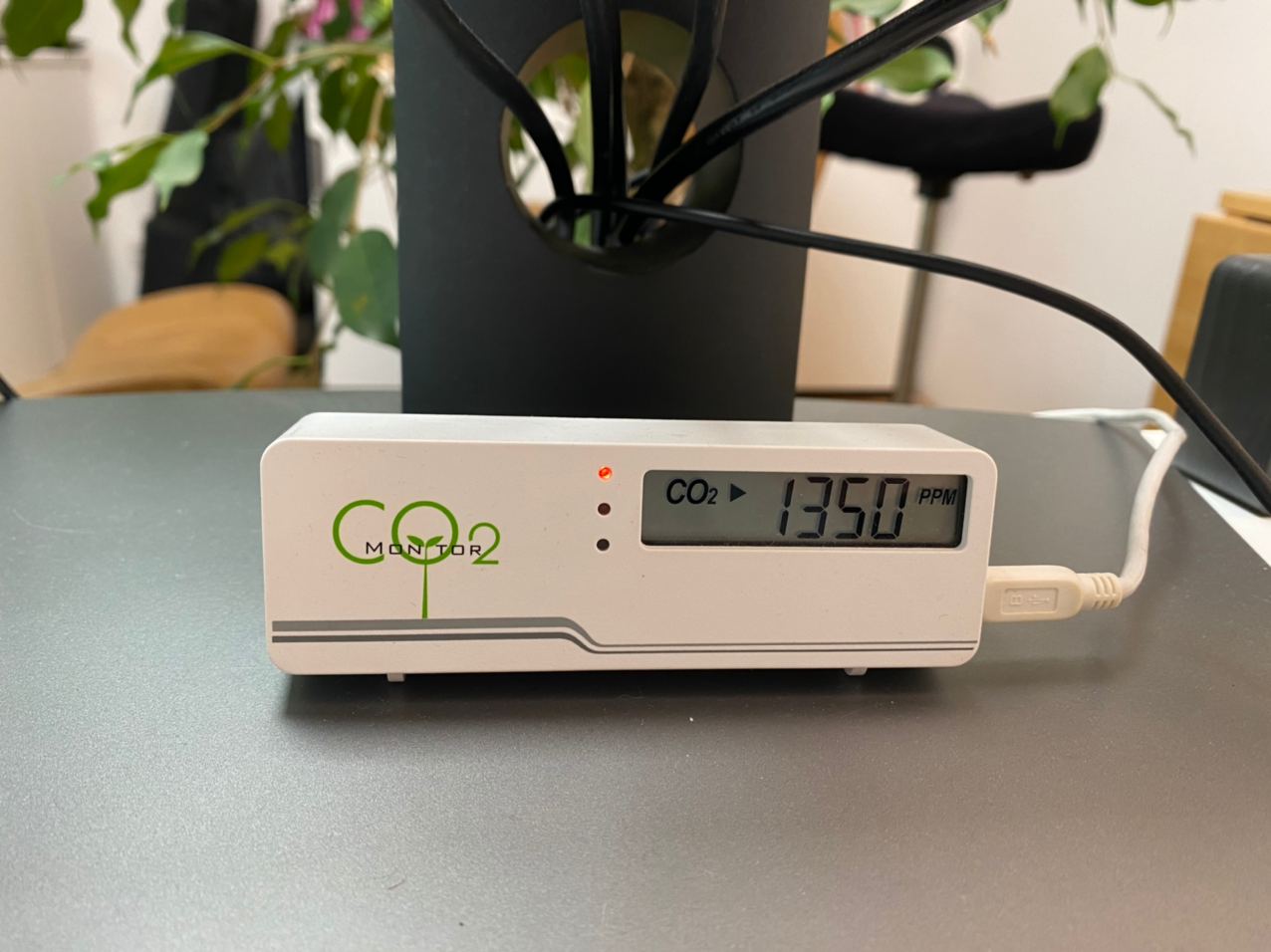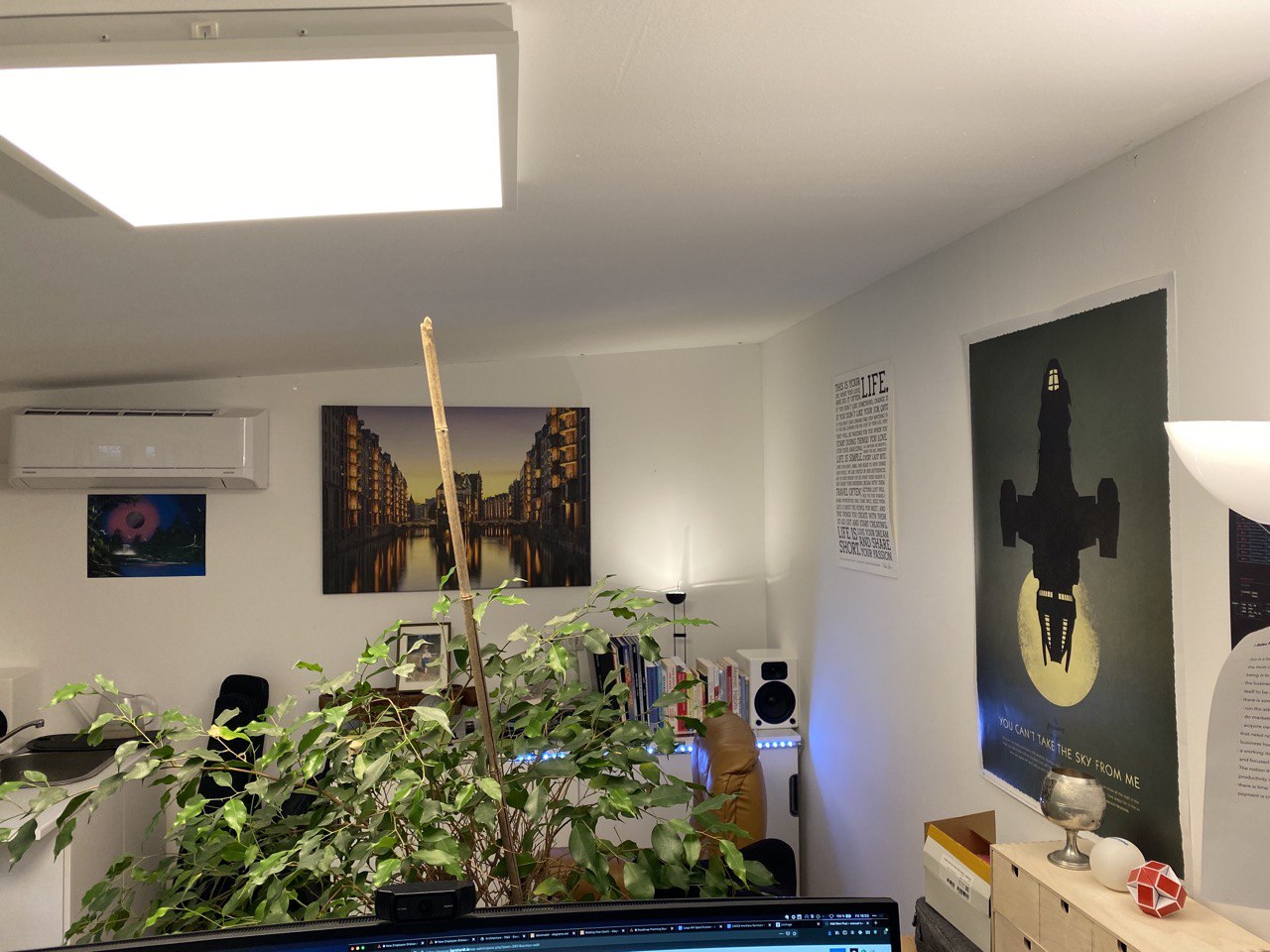Three key findings from ten years of home-office
Contents
It’s been nearly ten years that I have worked mainly from home (or more accurately, homes, as we moved around a bit). As it turns out, many people now work from home, less so by choice than by dystopian scenario C circumstance. Whilst I’m sure that there are already hundreds of articles on the topic I thought I’d write a bit about my experience and especially about some aspects that may not be that obvious and that took me a while to prioritize.
Indoor CO2 level
What is very often overlooked when working from home is the topic of air quality and particularly the one of CO2 level. Modern offices mostly have ventilation systems that constantly bring in fresh air (at an adjusted temperature) - you may not even be aware of them when working at an office as they’re often built into the ceiling. I’m not talking about air conditioning here - that’s a different process which focuses on changing the temperature, not the air itself.
Do you know the feeling you have after sitting one hour in a windowless meeting room with 6 other people and finally getting up again? What’s so tiring about those meetings often isn’t the content of the meeting itself or the other people (although arguably both can be) - it is the lack of fresh air, or rather, the increase of CO2 level in the room. CO2 level is measured in particle-per-million (PPM) and the outside air level is typically around 400-500 PPM (although that’s been raising at an alarming rate over the past century). There are by now quite a few studies on the topic, the findings are pretty clear: increased CO2 levels make it harder to focus and think:
"They found that, on average, a typical participant's cognitive scores dropped 21 percent with a 400 ppm increase in CO2".
Study by the Harvard School of Public Health
With a baseline of ~400 PPM (here in Vienna) you can now see why the current indoor CO2 as I am writing this article is not ideal:

So if you’re now working at home and your home does not have a built-in air-conditioning system, there are a few things that you can do:
- get a CO2 monitor. The one I have for 2 years now is the TFA Dostmann Air CO2ntrol mini and I am quit happy with it. It is important to get a good monitor / sensor, as wrong readings won’t help you much.
- get a flew plants. NASA has some recommendations on plants that are good filters. One thing to be aware of though is that plants are producing CO2 at night, so I wouldn’t recommend getting many of those plants if your home office is in your bedroom (which I would not recommend at all anyway). Or you could think of setting up a garden office with shed. It might feel good to take a break during the day and walk out into the middle of the plants to get some fresh air.
- advanced: set up proper air ventilation for your home office, whether it is a space you have created after finding a shed office for sale or inside your home. This is what I am doing now after spending a few years getting up to open and close the window every half hour (and wasting quite a bit of energy during the winter). This is a sizeable investment so you have to know you’re going to use the home office for a longer stretch of time
Movement (or lack thereof)
It took me ten years and a pandemic to figure out the prevalence of lack of movement in a “working from home” setting. Moving (walking, standing up, etc.) is built-in to the flow of working in an office with other people: going to the meeting room, fetching a coffee, going out for lunch, etc. — and even if it does not seem that much, all these steps add up during the day. When working from home for longer periods of time it requires discipline to build these habits back into the daily rhythm. Absence of commute (with all the advantages it brings, especially for longer, time-consuming commutes) also means absence of a planned period of movement. And unless you have a large apartment or house, chances are that the relative lack of space makes it less appealing to walk around.
I’m sure I could find a nice set of studies showing that lack of movement is bad for productivity and health. But you already know that. It is repeated so often by so many health professionals that the opposite effect takes place and people simply ignore the advice. The first question you get during a routine physical examination with your doctor is: do you exercise regularly? But this isn’t about exercising or doing sports (which are both very good things to do, of course) - it is about the fact that we humans are designed to walk. We evolved over millennia to function as hunter-gatherers. And it isn’t the past century that will undo and teach our bodies to function properly whilst sitting or standing all day long at a desk. So: move. Every. Day.

Now, clearly, the current pandemic and its restrictions do not help. But it may just be that because of these restrictions that restrict the natural type of movement that it is even more important to pay even more attention to getting enough of it.
A few actionable things you can do to help getting enough movement:
- get one of those fitness trackers and set a goal to do 10000 steps (or more) per day
- introduce a virtual commute at the beginning and end of your work day
- advanced: build a habit to run regularly (I run almost every day)
Light and lighting
I’m not mentioning this topic because of “light ergonomics”, i.e. having another source of light in addition to your computer screen in order to reduce eye strain. Or because of seasonal affective disorder. What I’m after here is how incorrect lighting can affect sleep and creativity.
Light and lighting help us think. Being always exposed to the same light - color and luminosity - is not only disruptive for our circadian rhythm, negatively impacting the sleep but also for our thought process.

I ended up equipping my office with Ikea Tradfri panels and bulbs which can be remote controlled and even programmed to change brightness and color / warmth as the day progresses. This simulation of daylight is a good way to feel comfortable in your space. An alternative for a more colourful approach could always be considered. Unique neon light fittings like these ones available at www.neonfilter.com are stylish and colourful, and they can help to change your office space making it a more creative work environment.
All the rest
To me the following points are obvious and I think they’re also covered in many other articles or aren’t necessarily related to working in a home-office. That does not make them less important though. So just for good measure here they are:
- if you can, avoid working in the same room than you sleep. If you can’t, physically separate the space with a folding screen
- use an ergonomic chair
- use a sit-stand desk and make it a habit to stand up from time to time
- do not make your office space very dull. It could create an impact on your creativity and dampen your mood while working. You can opt for light-colored dà ©cor or have an aesthetic wallpaper plastered on the wall.
- prefer one large / wide screen to several ones. Avoid using screens of different sizes (such as laptop & external monitor)
- if you type a lot, prefer an ortholinear keyboard and a touchpad to a classic keyboard and mouse to prevent carpal tunnel syndrome
- take regular breaks, using timers if need be
- drink enough water
- move. Seriously, don’t forget to move.
